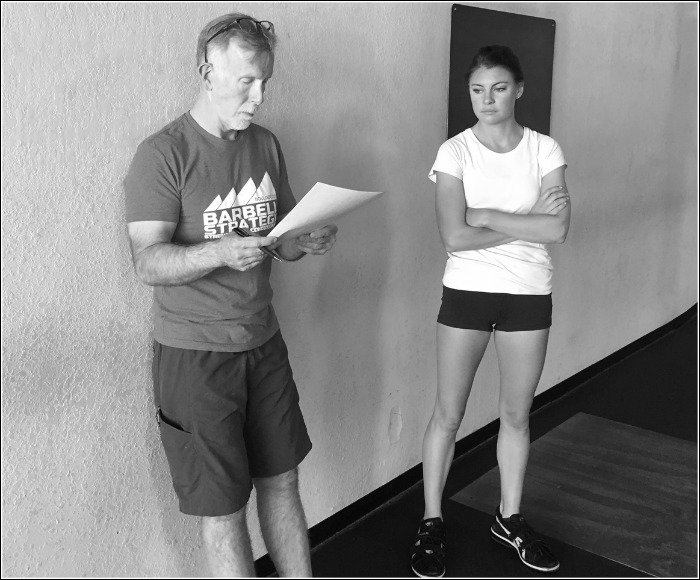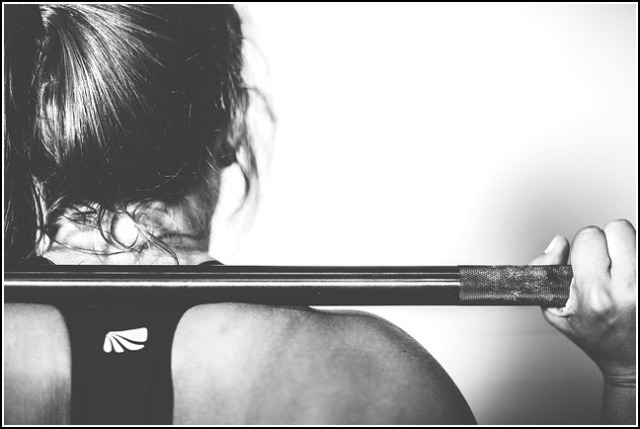Weight training for runners provides the best cross-training possible for any runner.
In fact, I don’t even consider weight lifting as a form of cross-training – it’s just part of the training that runners need to do!
But often, we don’t do the right type of strength training. Runners need to lift weights a certain way, prioritizing many elements of strength:
- Absolute strength (the ability to lift heavier weights)
- Power (the ability to produce a lot of force quickly)
- Durability (the ability to withstand running without injury)
And classes like Body Pump, bootcamps, P90X DVD’s, or CrossFit “WOD’s” aren’t going to work well. Not only won’t you develop the strength and power that’s necessary for speed, but you may actually hurt yourself and compromise your running.
No runner wants that!
On this page, you’ll find resources that explain ideal weight training for runners.
For our complete email course on weight lifting, sign up here for your first coaching lesson!
Weight Training for Runners: The Big Picture
When it comes to strength work for runners, there are three major goals:
- Injury prevention – toughen the connective tissues and strengthen the muscles to improve injury resilience
- Muscular power – produce force quickly so you can run faster and finish strong with a fast finishing kick
- Neuromuscular coordination – improve the communication pathways between the brain and muscles for higher running economy, efficiency, and a smooth stride
Most strength training options will help you with the first goal – injury prevention. And that’s a good thing, considering the annual injury rate!
Depending on the source, 35 – 80% of runners will get hurt every single year:
The majority of runners will get injured so it makes sense to prioritize injury prevention in your training. After all, you can’t run fast if you can’t run.
And weight training is one of the most effective method of injury prevention available to runners. Not only that, but most types of weight training for runners will work quite well to reduce injuries.
But the bad news is that most forms of strength training don’t accomplish the goals of power and neuromuscular efficiency – so while you might stay healthy, you won’t improve your performance.
And performance is about speed. It’s about running faster than ever before.
Runner-specific weight training prioritizes performance – so you can set more Personal Bests.
Don’t Make These Weight Lifting Mistakes

Strength Coach Randy Hauer and his athlete, pro runner Maggie Callahan
Unfortunately, there are a lot of misconceptions out there when it comes to weight training for runners.
Lifting can be more technical than running so unless you’re an expert or strength coach, developing the programming you’ll use in the gym can be difficult.
Thankfully, Strength Running has enlisted a top strength coach to clear up any confusion and clarify how runners should lift weights: Randy Hauer.
Randy is a USA Weightlifting National Coach, former record holder, and strength coach to many elite runners in Boulder Colorado. He has several pieces of advice for runners about to start a strength training program.
Weight Training Mistake: Classes, DVDs, and WODs Oh My!
This is the “grab bag” approach to strength training:
- Going to a Body Pump class a few times per week
- Relying on P90X, Insanity, or Jillian Michaels DVDs
- Doing random Runner’s World strength circuits
- Completing CrossFit WODs every week
Any strength session that includes circuits with little rest (like most fitness classes, DVDs, or CrossFit) is not optimally building strength. Randy adds:
Avoid circuits of several exercises in a row and instead take 1-2 minutes of recovery after each set. Like the talk test in running, you should be able to speak in complete sentences before you begin your next set.
We aren’t doing CrossFit, glycolytic, sweat puddles, and lactic acid bath stuff here. We’re doing real training.
Runners don’t need to structure their lifting workouts this way. It’s too hard! There’s an easier way.
Weight Training Mistake: Lifting Like a Bodybuilder
We’re runner, not bodybuilders. We don’t need to spend hours in the gym 5-6 days per week because we’re not trying to build muscle.
Runners also don’t need to isolate individual body parts. In other words, you don’t need a “legs day” followed by a “bis and tris day” – that’ll make developing runner-specific power and strength much more difficult.
Randy agrees:
Focus on compound, “larger” standing movements (running is done standing, right?).
Don’t lift distinct body parts on certain days (like chest day or back day, etc.). As a runner, you don’t care about “bis and tris.” You care about how strong you are.
The body isn’t a cobbled together bunch of parts that work separately, but rather it functions as a unit. Athletes should train it as a unit.
Randy teaches us that runners need to train their entire body – and it doesn’t take hours in the gym.
Weight Training Mistake: Relying on Stability
Too many runners have fallen in love with stability training with Bosu balls, wobble boards, and other stability tools. We’ve become enamored with “functional stability.”
But if you’re only focusing on stability training, you’re missing the #1 goal of weight training for runners: the ability to produce force.
Randy summarizes this well:
Avoid wobble boards, bosu, or swiss balls. They have their place in rehab situations, but really don’t serve any useful function when learning to produce force.
The goal is STRENGTH – or the ability to produce a lot of force against the ground. This makes you run faster!
This becomes clear when you think deeply about the goal of strength training.
If you can’t produce as much force on an unstable surface, you won’t create the stimulus needed for the neuromuscular adaptations that increase power and speed.
In our free strength ecourse, you’ll discover even more mistakes to avoid (and exactly what to do in the gym to prioritize strength, power, and injury prevention).
Does Weight Training for Runners Work?

Here’s Kirsten – you can read her case study here
The evidence is clear that weight training is critical for running performance and injury prevention. But how does it work in real life?
Let’s look at some specific examples.
Kirsten wasn’t sure how to balance lifting and running. But after using our weight training for runners guidance, she improved her half marathon by 29 minutes (at 6,000 feet altitude)!
James hit a performance plateau as a competitive runner and wasn’t improving. So he gave weightlifting a try – and ran Personal Bests in the 5k, 10k, and half marathon!
Kevin was a marathoner who didn’t know how to start with strength training. After getting step by step instructions, he made the commitment. And he gained muscle, lost fat, set a half marathon and marathon PR!
David qualified for Boston after thinking his running days were over. At age 73, he didn’t think that he’d be running marathons anymore. But with a strategic weight training program, he was able to keep running (and running fast!).
Weight Training Gear and Tools
Thankfully, you don’t need a fully stocked home gym to lift well. Most gym memberships will give you everything you need for proper weight training.
But it does make sense to have some simple tools available at home if you can’t make it to the gym for strength training.
Foam Roller: A simple self-massage tool, it can help increase flexibility, break up scar tissue, reduce myofascial adhesions, and loosen you up before running. Use it once a week or up to every day!
Medicine Ball: Perfect for beginner or advanced runners, a medicine ball can be used for a variety of strength exercises. They’re inexpensive and you can purchase more than one for different levels of difficulty.
I recommend the brand Valeo as they’re attractive, have a great rubber grip, and don’t cost too much.
Thera-band: A Thera-band is simply an exercise band that can make some body-weight exercises more challenging by increasing the resistance. It’s portable and perfect for traveling.
Q&A with Coach on Weight Lifting

I know you probably have a lot of questions when it comes to weight lifting for runners. And I want to introduce you to top coaches and elite runners who have answers.
Maggie Callahan: “Strength Training is Non-Negotiable”
Maggie is an elite runner for Brad Hudson’s Hudson Elite training team in Boulder, Colorado. A former Pac-10 steeplechase champion, Maggie has been lifting consistency for years and now considers weight training for runners “non-negotiable.”
We recorded a podcast with Maggie that goes over:
- Her ability to recover quickly is directly tied to lifting (and how good she feels on a daily basis)
- How strength training reestablished some of her lost athleticism from her high school years as a 4-sport athlete
- What she would say to women who think weight lifting at the gym might be intimidating
If you’re not sure if weightlifting will help your running, you won’t want to miss this podcast episode.
Randy Hauer: “Do not focus on endurance when lifting”
Randy is a USA Weightlifting National coach and trains multiple elite and collegiate distance runners in the gym.
He knows exactly what type of weight training is appropriate for runners.
We had Randy on the podcast to clarify all things lifting:
- HIIT / CrossFit training for runners
- When you should lift (Before or after running? Off days? Hard days?)
- Soreness from lifting weights
- Trail runners and lifting
- Mobility and movement fluency
- Is serious weight training just for “fast” runners?
- Is it right for older runners 50+? What about high school aged kids?
This top coach and professional athlete are here to walk you through how to lift well if you’re a runner.
And we have even more detailed info in our free strength course here.
Weightlifting Q&A
You might have questions. Let’s dive in.
I’m an older runner. Is weightlifting for me?
Absolutely! In fact, as you get older (particularly after age 40), strength training becomes even more important than when you were younger.
Not only will a regular weight training habit help you maintain your fitness and prevent injury, but help you maintain your muscle mass. For older runners, this should be a big goal (after age 40, you lose about 1% of your muscle mass per year).
For more detail, see how to combat the effects of aging here.
Advanced lifts like the deadlift are intimidating. Any suggestions?
I’ll let strength coach Tony Gentilcore take this question. He’s “the deadlift whisperer” and recognizes the importance of these strength movements for us endurance athletes.
In fact, he likes to point out that we’re already deadlifting all day every day! Every time we pick up a child or a bag of groceries from the floor, we’re performing a deadlift. Dozens of deadlifts per day can become risky if our form is poor or we don’t have a lot of strength.
So start deadlifting and it’ll not only help your running, but your parenting and grocery shopping skills!
I do a lot of bodyweight exercises. Is that enough?
It’s certainly a good place to start. And if the choice is “no strength training” or “bodyweight strength training” you should definitely choose the latter!
But it would be irresponsible not to note that while bodyweight exercises are good, weightlifting is better. An ideal strength program includes a balance of both to prioritize both your ability to stay healthy and prevent injuries, but also your ability to produce force and power.
Use progression with bodyweight exercises until you’re ready for weight training in the gym. You’ll be a much better runner for it.
Strength Training Exclusive Resources
Do you want to get stronger? Improve your body composition?
Maybe you’re a “pure runner” who only cares about speed, injury prevention, and a fast finishing kick.
Despite these very different training goals, weight training is how they’re accomplished. Lifting will:
- Help you stay healthy by preventing injuries that result from weak muscles, tendons, or ligaments
- Develop muscular power that enables speed and a fast finishing kick
- Build neuromuscular coordination that improves running economy (efficiency – so you can run faster with less effort)
But if you don’t want to take my word for it, don’t! Trust science:
- Strength training helps treat IT Band Syndrome (source)
- Women with runner’s knee have weaker hips than healthy runners (source – confirmed here)
- Resistance training improves trained runner’s economy by up to 8% (source)
- Explosive strength training makes your 5k faster by improved economy and muscle power (source)
- Weight lifting improves performance (speed), running economy, and muscle power (source)
It’s exciting how beneficial weight training can be for runners. If you’re convinced, I invite you to take the next step.
Sign up here for our complimentary email series on effective weight training for runners. You’ll learn:
- How to improve the “force production” of every stride
- Why “lift heavy” is good advice – but incomplete
- Why you should never (ever, ever) lift for endurance
- How the right strength work prevents running injuries
- How to lift for explosivity (in just 2 workouts per week)
Register here and the first lesson will hit your inbox in just a few minutes.
